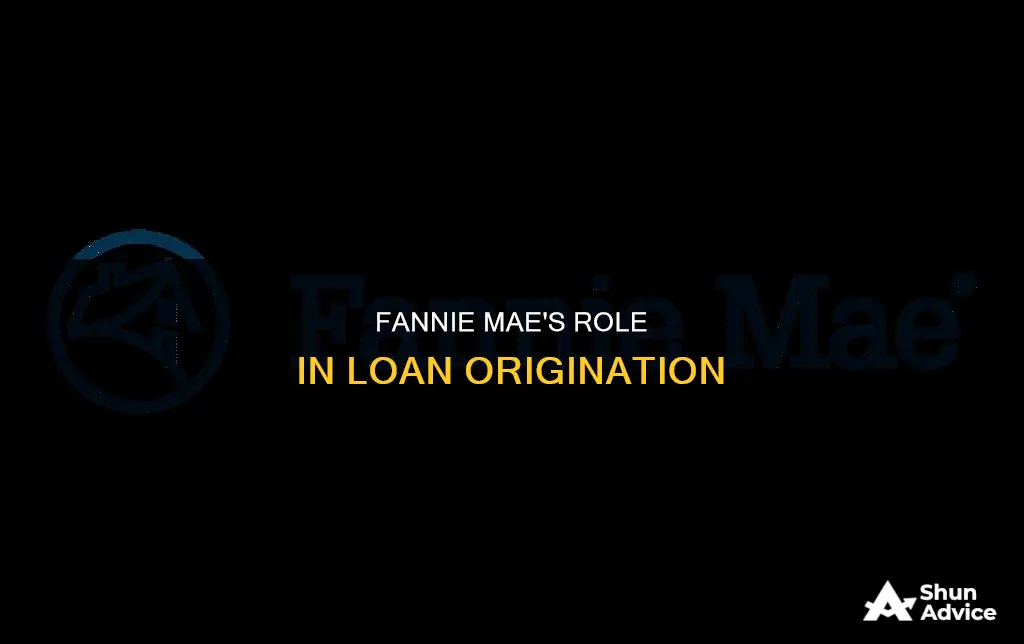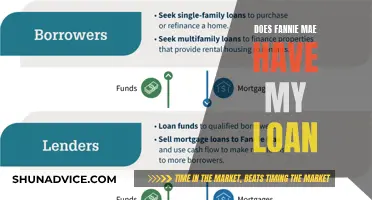
The Federal National Mortgage Association (FNMA), or Fannie Mae, is a government-sponsored enterprise that does not originate loans or lend money directly to homebuyers or multifamily property owners. Instead, it purchases and backs mortgage loans that meet its requirements from lenders, including big banks and lenders. By investing in the mortgage market, Fannie Mae creates liquidity for lenders, allowing them to underwrite more mortgages. The mortgages it purchases must meet strict criteria, and Fannie Mae develops and maintains underwriting and eligibility standards for its loans. It also provides resources for lenders and helps increase access to mortgage credit for communities across the nation.
| Characteristics | Values |
|---|---|
| Purpose | To provide liquidity and stability to America's housing market and to promote access to affordable mortgage credit in communities throughout the country |
| How it works | Fannie Mae purchases and backs mortgage loans for borrowers that meet its requirements from lenders. It does not originate loans or lend money directly to homebuyers or multifamily property owners |
| Loan types | Conventional loans, conforming loans, fixed-rate mortgages, refinancings, rental units, HomeReady® program |
| Loan requirements | Must meet strict criteria, including the Statement on Subprime Lending issued by the federal government; limit for a conventional loan for a single-family home in 2023 is $726,200 for most states, $1,089,300 for high-cost areas |
| Role | Develop and maintain underwriting and eligibility standards; establish servicing standards; provide multi-language resources for lenders; partner with lenders to decrease risk |
| Other | Has been publicly traded since 1968; government-sponsored enterprise; under the conservatorship of the Federal Housing Finance Agency |
What You'll Learn
- Fannie Mae doesn't originate loans, but it does buy and guarantee them
- The Federal National Mortgage Association (FNMA), or Fannie Mae, purchases and backs mortgage loans
- The US Congress created Fannie Mae to finance home purchases for those with modest incomes
- Fannie Mae works with lenders to increase liquidity and maintain affordable mortgage rates
- The HomeReady® program offers a $2,500 credit to those making less than half the area median income

Fannie Mae doesn't originate loans, but it does buy and guarantee them
The Federal National Mortgage Association (FNMA), or Fannie Mae, is a government-sponsored enterprise that does not originate loans or lend money directly to homebuyers or multifamily property owners. Instead, it purchases and guarantees mortgage loans that meet its requirements from lenders, including big banks and lenders. By doing so, Fannie Mae creates liquidity for lenders, allowing them to underwrite more mortgages and maintain a stable, affordable, and efficient mortgage market in the United States.
Fannie Mae has specific criteria that the mortgages it purchases and guarantees must meet. For example, there are limits on the loan amounts for single-family homes, which vary depending on the state and territory. To do business with Fannie Mae, mortgage lenders must also comply with the Statement on Subprime Lending issued by the federal government to address the risks associated with subprime loans.
Fannie Mae securitizes the loans it purchases into mortgage-backed securities (MBS) and sells them to investors worldwide. The MBS investors are guaranteed timely payment of principal and interest by Fannie Mae, which assumes the credit risk on the underlying loans. These guaranty fees contribute to Fannie Mae's revenue stream.
Fannie Mae also works to increase access to affordable mortgage credit for low- to moderate-income homebuyers and homeowners. Its products are designed to meet the needs of borrowers, including those with modest incomes. For example, the HomeReady® program offers a credit of up to $2,500 towards closing costs for individuals who make less than half of the area median income.
In summary, while Fannie Mae does not originate loans, it plays a crucial role in the mortgage market by purchasing, guaranteeing, and securitizing loans that meet its standards. This, in turn, helps to create liquidity, maintain stability, and promote access to affordable mortgage credit for borrowers across the United States.
MPN Student Loans: Who Needs to Fill Them Out?
You may want to see also

The Federal National Mortgage Association (FNMA), or Fannie Mae, purchases and backs mortgage loans
The Federal National Mortgage Association (FNMA), or Fannie Mae, is a government-sponsored enterprise that does not originate loans or lend money directly to homebuyers. Instead, it purchases and backs mortgage loans that meet its requirements from lenders, including big banks and lenders. By investing in the mortgage market, Fannie Mae creates liquidity for lenders, allowing them to underwrite more mortgages.
Fannie Mae has specific criteria for the mortgages it purchases and guarantees. For example, the loan limit for a conventional single-family home loan in most states and territories in 2023 is $726,200, while in certain high-cost areas, such as Hawaii and Alaska, the limit is $1,089,300. To do business with Fannie Mae, lenders must comply with the federal government's Statement on Subprime Lending, which addresses the risks associated with subprime loans.
Fannie Mae's role in the mortgage market is to provide liquidity and stability to the housing market and promote access to affordable mortgage credit for low- to moderate-income homebuyers and homeowners. It offers mortgage options that support the real estate market and current homebuyers and homeowners looking to refinance. For example, the HomeReady® program offers a $2,500 credit towards closing costs for those making less than half the area median income.
Fannie Mae also works to maintain underwriting and eligibility standards for the loans it acquires, using its proprietary single-family automated underwriting system, Desktop Underwriter® (DU®). It establishes servicing standards, including borrower assistance options for those experiencing financial distress. Additionally, its Multifamily business line finances affordable rental housing by leveraging private capital through its Delegated Underwriting and Servicing (DUS®) program.
Fafsa and Loan Providers: Who Chooses?
You may want to see also

The US Congress created Fannie Mae to finance home purchases for those with modest incomes
The US Congress created the Federal National Mortgage Association (FNMA), or Fannie Mae, in 1938 during the Great Depression. The aim was to stimulate the housing market by making mortgages more accessible to low- and moderate-income borrowers.
Fannie Mae does not directly offer mortgages to borrowers. Instead, it purchases mortgages on the secondary mortgage market and pools them to create mortgage-backed securities (MBS). These MBS are then sold as investments to large institutional buyers, such as insurance companies and investment banks. This process provides liquidity to the market, allowing lenders to offer more mortgages to borrowers.
Fannie Mae also guarantees the payments of principal and interest on its MBS, reducing the risk to banks and making them more willing to loan money. It only purchases mortgages that meet strict criteria, such as loan size, loan-to-value ratio, and borrower credit score.
Fannie Mae has played a significant role in increasing access to mortgage credit and affordable housing for those with modest incomes. It has helped to create a stable, affordable, and efficient mortgage market in the United States, providing opportunities for homeownership that were previously out of reach for many.
While Fannie Mae does not directly originate mortgages, it provides the necessary financial backing and guarantees to enable lenders to offer mortgages to a wider range of borrowers, including those with modest incomes.
Explicit Costs: Are Loans Included?
You may want to see also

Fannie Mae works with lenders to increase liquidity and maintain affordable mortgage rates
The Federal National Mortgage Association (FNMA), or Fannie Mae, was created by the United States Congress to open up a stream of financing for home purchases, making it accessible even to those with modest incomes. It does not originate loans or lend money directly to homebuyers or multifamily property owners. Instead, it works with lenders to increase liquidity and maintain affordable mortgage rates.
Fannie Mae purchases and backs mortgage loans for borrowers that meet its requirements. The FHFA sets requirements for Fannie Mae, called conforming loan limits. These mortgage loans, known as conforming mortgages, are guaranteed by Fannie Mae. This means that they will compensate investors if the borrower defaults. Fannie Mae packages these loans into mortgage-backed securities (MBS) before selling them on the open bond market to investors. An MBS may consist of 1,000 loans or more with similar characteristics.
Fannie Mae has certain rules, such as not buying non-conforming loans. The mortgages it purchases and guarantees must meet strict criteria. For example, the limit for a conventional loan for a single-family home in 2023 is $726,200 for most states, the District of Columbia, and Puerto Rico. For certain states and territories with high housing costs, such as Hawaii, Alaska, Guam, and the US Virgin Islands, the limit is set at $1,089,300. In 2025, the loan limit for most of the country is expected to be $806,500, indicating a 5.21% increase over the 2024 limit.
Fannie Mae's work helps lenders offer affordable mortgage loans, like the 30-year, fixed-rate mortgage, to low- to moderate-income homebuyers and homeowners. It also promotes access to safe, quality housing for renters. In 2023, it provided $369 billion in liquidity to the US mortgage market, enabling the financing of approximately 1.5 million home purchases, refinancings, and rental units. A significant majority of these were affordable to families earning at or below 120% of the Area Median Income, providing support for both workforce and affordable housing.
FAFSA Summer Loans: What You Need to Know
You may want to see also

The HomeReady® program offers a $2,500 credit to those making less than half the area median income
Fannie Mae was created by the United States Congress to open up financing for home purchases, making them accessible even to those with modest incomes. It works to maintain a stable, affordable, and efficient mortgage market in the United States. It does this by investing in the mortgage market, creating more liquidity for lenders, which in turn allows them to underwrite more mortgages.
Fannie Mae's HomeReady® program is a mortgage solution that reduces the barriers to homeownership for low-income and very low-income borrowers. It offers a $2,500 credit for eligible first-time homebuyers, and considers positive rent payment history in loan eligibility. The $2,500 credit is available to those who earn at or below 50% of the area median income (AMI). This is determined by the property's location. The credit can be used towards the down payment requirement of 3%.
HomeReady® also offers flexible funding options, allowing borrowers to use a variety of sources for a down payment or closing costs. It also offers reduced PMI costs and flexible income sources. Borrowers can also take advantage of the Fannie Mae HomeView® program to satisfy the homeownership education requirement.
Fannie Mae does not directly offer the HomeReady® program to borrowers. It is available through participating mortgage lenders.
Who Owns My Mortgage Loan? Fannie, Freddie, and You
You may want to see also
Frequently asked questions
No, Fannie Mae does not originate loans. They buy loans that meet their requirements from lenders.
Fannie Mae works to maintain a stable, affordable, and efficient mortgage market in the United States. It provides liquidity and stability to America's housing market and promotes access to affordable mortgage credit.
The United States Congress created Fannie Mae in response to the annual foreclosure rates rising every year from 1926 to 1934. The aim was to open up financing for home purchases, even for those with modest incomes.
The mortgages purchased and guaranteed by Fannie Mae must meet strict criteria. For example, the limit for a conventional loan for a single-family home in 2023 is $726,200 for most states.
Fannie Mae offers mortgage options that support the real estate market and current home buyers and homeowners looking to refinance. They also provide multi-language resources for lenders and help increase access to mortgage credit in all communities.







